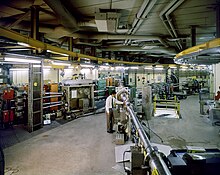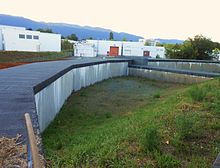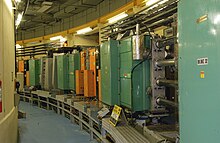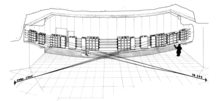
Back Proton Synchrotron Booster German Impulsor del Sincrotrón de Protones Spanish Proton Synchrotron Booster French Protonszinkrotron-erősítő Hungarian Proton Synchrotron Booster Italian Protonų sinchrotrono stiprintuvas Lithuanian
 | |
| Current particle and nuclear facilities | |
|---|---|
| LHC | Accelerates protons and heavy ions |
| LEIR | Accelerates ions |
| SPS | Accelerates protons and ions |
| PSB | Accelerates protons |
| PS | Accelerates protons or ions |
| Linac 3 | Injects heavy ions into LEIR |
| Linac4 | Accelerates ions |
| AD | Decelerates antiprotons |
| ELENA | Decelerates antiprotons |
| ISOLDE | Produces radioactive ion beams |
| MEDICIS | Produces isotopes for medical purposes |




The Proton Synchrotron Booster (PSB) is the first and smallest circular proton accelerator (a synchrotron) in the accelerator chain at the CERN injection complex, which also provides beams to the Large Hadron Collider.[1] It contains four superimposed rings with a radius of 25 meters, which receive protons with an energy of 160 MeV from the linear accelerator Linac4 and accelerate them up to 2.0 GeV, ready to be injected into the Proton Synchrotron (PS). Before the PSB was built in 1972, Linac 1 injected directly into the Proton Synchrotron, but the increased injection energy provided by the booster allowed for more protons to be injected into the PS and a higher luminosity at the end of the accelerator chain.
The PSB does not only act as a proton injector for the PS but also provides protons at an energy of 1.4 GeV to On-Line Isotope Mass Separator (ISOLDE), the only experimental facility directly linked to the PSB.
- ^ "CERN – Division PS – LHC-PS project" Retrieved on 09 July 2018
© MMXXIII Rich X Search. We shall prevail. All rights reserved. Rich X Search